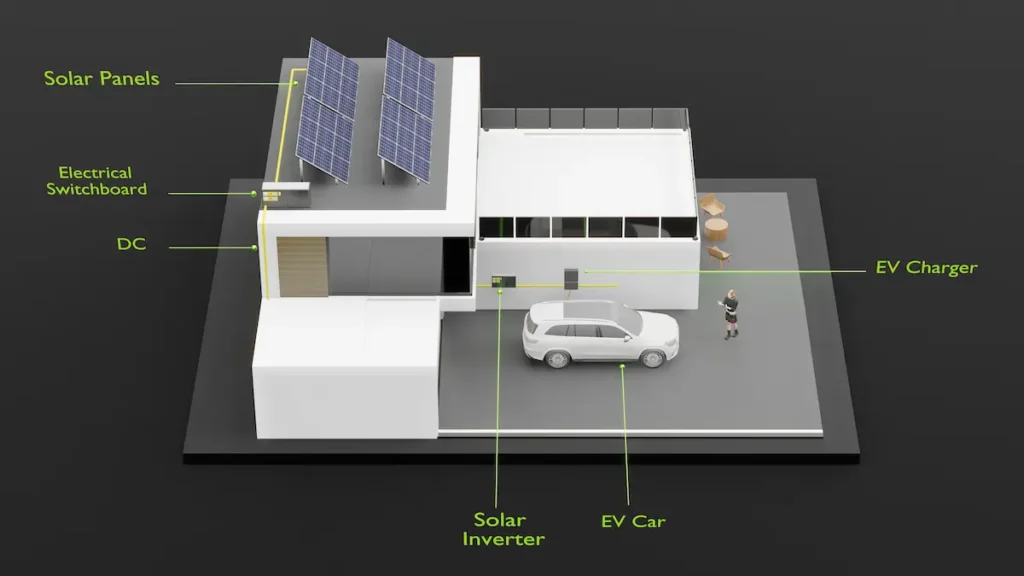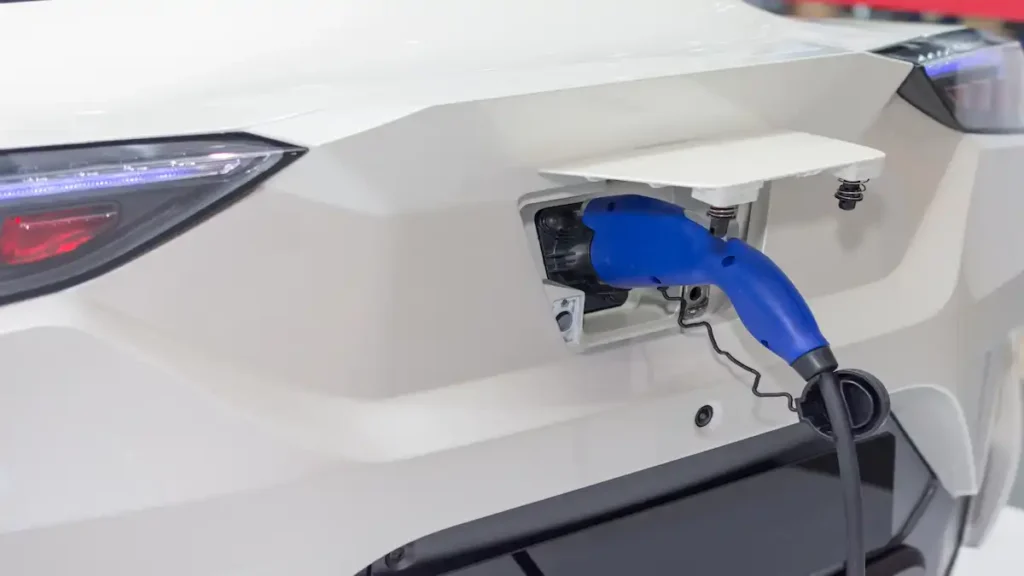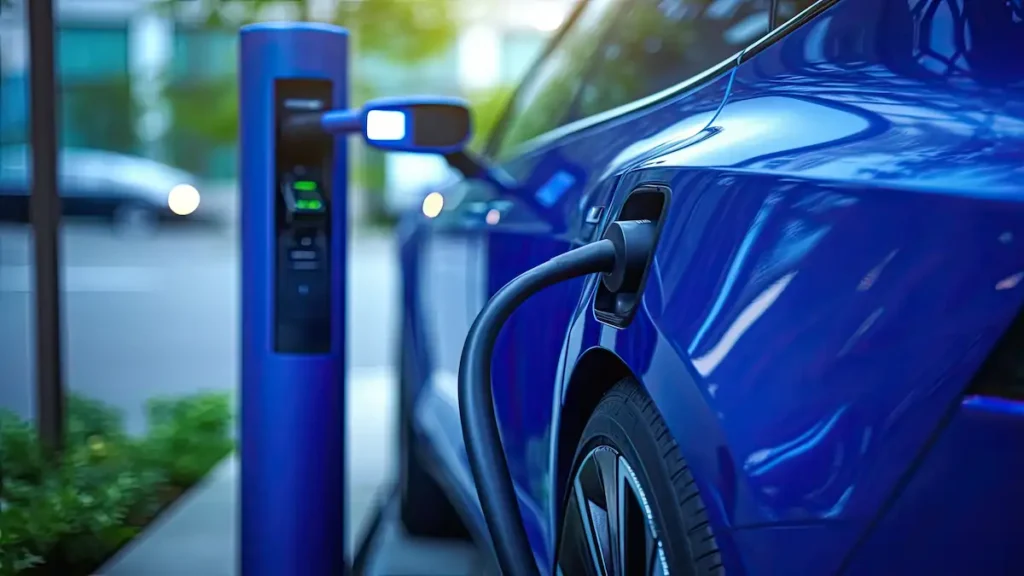As electric vehicles (EVs) continue to grow in popularity, many drivers are exploring clean energy charging options to reduce their carbon footprint. One increasingly popular solution is the use of Level 2 portable EV chargers powered by clean energy sources like solar, wind, or hydro. These chargers offer faster speeds than Level 1 units—and when combined with renewable power, they promise a greener, smarter way to fuel your EV. But can they reliably power your car for everyday use? In this guide (Top Solar Picks) TSP, we’ll explore how Level 2 portable EV chargers work with clean energy systems, their benefits, limitations, and whether they’re a viable solution for at-home or on-the-go EV charging.
How Level 2 Portable EV Chargers Work
Level 2 portable EV chargers are a faster, more flexible alternative to basic Level 1 chargers. While Level 1 chargers plug into standard household outlets and take 20+ hours for a full charge, Level 2 chargers operate on a 240-volt power supply, significantly reducing charging time to just 4–8 hours—perfect for overnight use or daily commuting needs.
What makes Level 2 chargers portable is their compact design and ability to plug into compatible outlets (like NEMA 14-50 or 6-50 sockets), often found in garages, RV parks, or outdoor charging stations. Some models even come with adapters, allowing drivers to charge in multiple locations without hardwiring anything permanently.
Here’s a simple breakdown of how they work:
Power Input: They draw 240V from your home’s electrical system or a compatible external outlet.
Current Flow: The charger’s internal circuitry regulates the electricity and safely delivers it to your EV’s battery via the charging cable.
Smart Features: Many portable Level 2 chargers offer Wi-Fi or Bluetooth connectivity, allowing you to schedule charging, monitor energy use, or pair with clean energy sources like solar inverters.
When paired with a clean energy system—like a solar panel array—these chargers can directly draw from renewable energy, making your EV charging not only faster but also far more sustainable.
In short, Level 2 portable EV chargers combine speed, convenience, and energy efficiency—and when integrated with clean energy sources, they can transform your home into an eco-friendly fueling station.
Understanding Clean Energy Charging
Clean energy charging is powering electric cars using electricity from clean energy sources. Instead of drawing power from electricity generated by coal, oil, or gas, the method involves energy from the sun, winds, or flowing water. Power from the sun is converted to electricity by solar panels, winds are harnessed by wind farms, and hydropower plants harness energy from rivers and dams. The transition is not symbolic—it is a question of replacing dirty sources of energy with clean, renewable sources with a lesser environmental footprint.
Where solar panels on the rooftops of houses are the norm, or where local grids are becoming supplemented by windmills or hydroelectric generators, clean energy charging is not just possible but extremely convenient. It’s a revolution in transportation that marries environmental awareness with energy technology.
Related Articles
Car Electrical Repair Near Me: A Quick Guide for EV and Hybrid Owners
Manchester Electric Vehicles and Rentals: What EV Drivers Need to Know
Why It’s More Important Than Ever Today
Transportation is one of the largest emitters of greenhouse gases globally. Going electric is a step in the right direction, but it’s even better when the EVs are charged with renewably generated electricity. As long as we’re still powering electric cars with fossil fuel-generated electricity, though, we’re not realizing the full environmental benefit these cars have to offer.
Governments and society are rapidly embracing clean energy programs. Solar rebates, renewable portfolio standards, and smart-grid technologies all contribute to the day when clean energy charging becomes the rule rather than the exception. And for consumers, that means a chance to reduce the dependence on utility companies and fossil fuels and save on long-term energy costs.
So, Is It Reliable?
Reliability tends to be the most controversial justification for clean energy charging. Critics cite the variability of wind and sun power. What do you do, then, on a cloudy day or when the wind is not blowing? The good news is that renewable systems today are much more advanced and typically paired with energy storage technologies.
Solar energy, for example. Of course, there is variation depending on the weather, but residential solar installations typically include battery backup, such as Tesla‘s Powerwall or LG Chem batteries. The batteries store a surplus of electricity by day and offer a steady current during the night or on low-sun days. Your EV, therefore, can keep charging overnight even if the sun didn’t shine that day.
Public facilities are also coming along. Fast-charging stations powered by solar or wind are already installed in cities and along roadsides. Others are grid-connected, so they run on renewable energy when it is available but switch to the usual methods of electricity when necessary—to offer round-the-clock charging.
Everyday Experiences with Clean Energy Charging

Consider those homeowners who have installed solar rooftop systems and now power both their houses and EVs with clean sunlight. Not only do they see a reduction in their utility bills, but a sense of empowerment—controlling their own energy consumption and production.
Then there are the companies that are leading the way. IKEA and Walmart, for instance, have installed solar-powered EV charging points in numerous locations. In California, some municipalities require new constructions to be solar-ready, paving the way for even wider use of clean energy charging.
These are not niche applications. They’re proof that clean energy charging is already operating in a wide range of settings from suburban homes to corporate office parks to municipal transit fleets.
The Bigger Picture
In addition to individual benefits, clean energy charging has broader implications. It’s a shift towards decentralized energy systems, where electricity is produced closer to the point of use. This reduces the burden on national grids, reduces transmission losses, and increases resilience during outages or emergencies. Solar and battery storage-enabled homes can continue to charge their EVs during heatwaves or outages as neighbors utilize diesel generators or wait for the grid to come back online.
Then, of course, there is the economic consideration. While the initial cost of solar panels or a battery system may seem intimidating, the cost is decreasing, and rebates or incentives are available in most locales. Many consumers end up paying for the installation in the long run through lower monthly utility bills and lower fuel costs by not having to buy gasoline.
Setting It Up at Home
If you are considering home clean energy charging, first consider what your usage is. How many miles daily do you drive? How much kilowatt-hour of electricity does your EV consume per mile? That gives you an idea of the size of solar or wind installation you might need.
Most residences are able to accommodate Level 2 charging, and it’s more than adequate for overnight charging. With a solar system and battery bank storage, this system will give you total energy independence for your vehicle.
Battery storage is especially critical if you’re going to be using only clean energy. It will allow you to store excess energy from the day and use it during the evening or when there is cloud cover. Without a battery, you’d have to take the grid in such cases—something that could still be fossil fuel energy in some areas, depending on where you live.
Benefits Beyond the Environment
It’s clear clean energy charging is wonderful for the environment, but that’s just the beginning. It also insulates you against rising electricity costs, adds value to your property, and sets you up for a future that’s sustainable. Most importantly, it provides you with peace of mind. There’s a very satisfying sense of knowing your car is being charged from the sun or wind.
And then there is the convenience. You don’t have to depend on gas stations anymore or even public EV charging stations. You charge overnight. And through smart systems and apps, you can monitor your energy generation, usage, and even plan when your EV charges for peak performance.
Challenges Still Exist

There is no such thing as a perfect system. Clean energy charging is not without its drawbacks, the most obvious of which is expense. Solar installations, batteries, and EV charging stations are not inexpensive, even when governments offer rebates. Not all homes are suitable for solar panels, and not all locations have constant wind or sunlight. Installation can also be tricky, especially if you are retrofitting your electrical system.
All that being said, the technology itself is also evolving at a breakneck rhythm. Batteries are getting more efficient and cheaper. Solar panels are getting smaller and more efficient. And companies are providing bundled packages that simplify the entire process—installation through monitoring—completely.
Looking Ahead
We’re entering an era where clean energy charging won’t just be a personal choice—it will be part of infrastructure and policy on a bigger scale. Solar-integrated transportation centers are already being developed in cities. Automakers are beginning to offer packages that include solar panels with the sale of an EV. And utilities are converting to renewable energy faster than ever.
Imagine roads lined with solar canopies charging vehicles as they travel, or neighborhoods with cooperative clean microgrids energizing all homes and vehicles. No longer science fiction, these are prototypes now being tested.
Final Thoughts: Can Clean Energy Charging Be Trusted?
Yes, and increasingly so each day. Although the ride is not smooth all the time, the technology, the infrastructure, and the economics are coming together to facilitate clean energy charging that is sustainable and viable. If properly equipped—a very important aspect of which is energy storage—EV owners can enjoy stable, consistent, and truly green charging.
It’s more than a trend. It’s the logical next step for any of us who desire to align our lifestyle with sustainability and smart technology. Clean energy charging isn’t only feasible—it’s healthier for you and the planet.
Common Questions
Can Level 2 portable EV chargers run on solar power?
Yes, with the right setup, many portable Level 2 chargers can draw energy from solar panels or other renewable sources.
Can I power my EV with solar panels alone?
Yes, many homes with enough solar capacity and battery storage charge their EVs without ever taking power from the grid.
Is charging clean energy more expensive?
Initial investment is high, but it is a good economic choice with future fuel and electricity savings.
What if the sun doesn’t shine or the wind doesn’t blow?
Battery systems and grid backup provide you strong power when the renewables are not available.
Is the technology ubiquitous?
Accessibility and effectiveness vary by place, but the infrastructure is expanding rapidly.
Can I begin small?
Yes. The majority of homeowners begin with partial solar systems and build up as their budgets and requirements increase.
Author
Top Solar Picks, founded by John, a Solar Energy Writer and Researcher with over 12 years of experience in renewable energy, is dedicated to helping homeowners and businesses make informed, data-driven decisions about solar power. John’s expertise and research pr...

